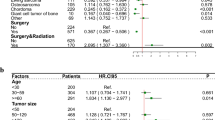Abstract
Purpose
In the diagnostic process of primary bone tumors, patient age, tumor localization and to a lesser extent sex affect the differential diagnosis. We therefore aim to develop a pretest probability calculator for primary malignant bone tumors based on population data taking these variables into account.
Methods
We access the SEER (Surveillance, Epidemiology and End Results Program of the National Cancer Institute, 2015 release) database and analyze data of all primary malignant bone tumors diagnosed between 1973 and 2012. We record age at diagnosis, tumor localization according to the International Classification of Diseases (ICD-O-3) and sex. We take relative probability of the single tumor entity as a surrogate parameter for unadjusted pretest probability. We build a probabilistic (naïve Bayes) classifier to calculate pretest probabilities adjusted for age, tumor localization and sex.
Results
We analyze data from 12,931 patients (647 chondroblastic osteosarcomas, 3659 chondrosarcomas, 1080 chordomas, 185 dedifferentiated chondrosarcomas, 2006 Ewing’s sarcomas, 281 fibroblastic osteosarcomas, 129 fibrosarcomas, 291 fibrous malignant histiocytomas, 289 malignant giant cell tumors, 238 myxoid chondrosarcomas, 3730 osteosarcomas, 252 parosteal osteosarcomas, 144 telangiectatic osteosarcomas). We make our probability calculator accessible at http://ebm-radiology.com/bayesbone/index.html. We provide exhaustive tables for age and localization data. Results from tenfold cross-validation show that in 79.8 % of cases the pretest probability is correctly raised.
Conclusions
Our approach employs population data to calculate relative pretest probabilities for primary malignant bone tumors. The calculator is not diagnostic in nature. However, resulting probabilities might serve as an initial evaluation of probabilities of tumors on the differential diagnosis list.




Similar content being viewed by others
References
Miller TT (2008) Bone tumors and tumorlike conditions: analysis with conventional radiography. Radiology 246:662–674. doi:10.1148/radiol.2463061038
Unni KK (2006) Dahlin’s bone tumors: general aspects and data on 10,165 cases. Lippincott Williams & Wilkins, Philadelphia
Mulder JD, Kroon HM, Schutte HE, Taconis WK (1993) Radiologic atlas of bone tumors, revised edn. Elsevier, Amsterdam
(2002) Rare Diseases Act of 2002, Public Law 107-280
Dawson NV, Arkes HR (1987) Systematic errors in medical decision making: judgment limitations. J Gen Intern Med 2:183–187. doi:10.1007/BF02596149
Bar-Hillel M (1980) The base-rate fallacy in probability judgments. Acta Psychol (Amst) 44:211–233. doi:10.1016/0001-6918(80)90046-3
Casscells W, Schoenberger A, Graboys TB (1978) Interpretation by physicians of clinical laboratory results. N Engl J Med 299:999–1001. doi:10.1056/NEJM197811022991808
Sox HC, Higgins MC, Owens DK (2013) Medical decision making. Wiley, West Sussex
Lodwick GS, Haun CL, Smith WE, Keller RF, Robertson ED (1963) Computer diagnosis of primary bone tumors. Radiology 80:273–275. doi:10.1148/80.2.273
Lodwick GS (1965) A probabilistic approach to the diagnosis of bone tumors. Radiol Clin North Am 3:487–497
Kahn CE, Laur JJ, Carrera GF (2001) A Bayesian network for diagnosis of primary bone tumors. J Digit Imaging 14:56–57. doi:10.1007/BF03190296
Lejbkowicz I, Wiener F, Nachtigal A, Militiannu D, Kleinhaus U, Applbaum YH (2002) Bone Browser a decision-aid for the radiological diagnosis of bone tumors. Comput Methods Programs Biomed 67:137–154. doi:10.1016/S0169-2607(01)00115-8
World Health Organization (2014) International classification of diseases for oncology. World Health Organization, Geneva
Surveillance, Epidemiology, and End Results (SEER) Program (www.seer.cancer.gov) SEER*Stat Database: Incidence—SEER 9 Regs Research Data, Nov 2014 Sub (1973–2012) Katrina/Rita Population Adjustment—Linked To County Attributes—Total U.S., 1969-2013 Counties, National Cancer Institute, DCCPS, Surveillance Research Program, Surveillance Systems Branch, released April 2015, based on the November 2014 submission
Hand DJ, Yu K (2001) Idiot’s Bayes: not so stupid after all? Int Stat Rev 69:385–398. doi:10.2307/1403452
Charniak E (1991) Bayesian networks without tears. AI Mag 12:50
Liu YI, Kamaya A, Desser TS, Rubin DL (2011) A Bayesian network for differentiating benign from malignant thyroid nodules using sonographic and demographic features. Am J Roentgenol 196:W598–W605. doi:10.2214/AJR.09.4037
Frank E, Bouckaert RR (2006) Naive Bayes for text classification with unbalanced classes. In: Fürnkranz J, Scheffer T, Spiliopoulou M (eds) Knowledge Discovery in Databases: PKDD 2006. Springer, Berlin, pp 503–510
Manning CD, Schütze H (1999) Foundations of statistical natural language processing. MIT Press, Cambridge
Steyerberg E (2008) Clinical prediction models: a practical approach to development, validation, and updating. Springer, New York
Domingo P, Pazzani M (1996) Beyond independence: conditions for the optimality of the simple Bayesian classifier. In: Proceedings of the 13th international conference on machine learning, pp. 105–112
Hudson T (1987) Radiologic-pathologic correlation of musculoskeletal lesions. Williams and Wilkens, Baltimore
Walden MJ, Murphey MD, Vidal JA (2008) Incidental enchondromas of the knee. Am J Roentgenol 190:1611–1615. doi:10.2214/AJR.07.2796
Freyschmidt J, Ostertag H, Saure D (1981) Fibrous metaphyseal defect (fibrous cortical defect, non-ossifying fibroma). Paper II: differential diagnosis (author’s transl). RöFo Fortschritte Auf Dem Geb Röntgenstrahlen Nukl 134:392–400. doi:10.1055/s-2008-1056377
Lodwick GS (1971) The bones and joints. Year Book Medical Publishers, Chicago
Author information
Authors and Affiliations
Corresponding author
Ethics declarations
Conflict of interest
The authors declare that they have no conflict of interest.
Ethical approval
All procedures performed in studies involving human participants were in accordance with the ethical standards of the institutional and/or national research committee and with the 1964 Helsinki Declaration and its later amendments or comparable ethical standards. For this type of study, formal consent is not required.
Electronic supplementary material
Below is the link to the electronic supplementary material.
Rights and permissions
About this article
Cite this article
Benndorf, M., Neubauer, J., Langer, M. et al. Bayesian pretest probability estimation for primary malignant bone tumors based on the Surveillance, Epidemiology and End Results Program (SEER) database. Int J CARS 12, 485–491 (2017). https://doi.org/10.1007/s11548-016-1491-3
Received:
Accepted:
Published:
Issue Date:
DOI: https://doi.org/10.1007/s11548-016-1491-3




